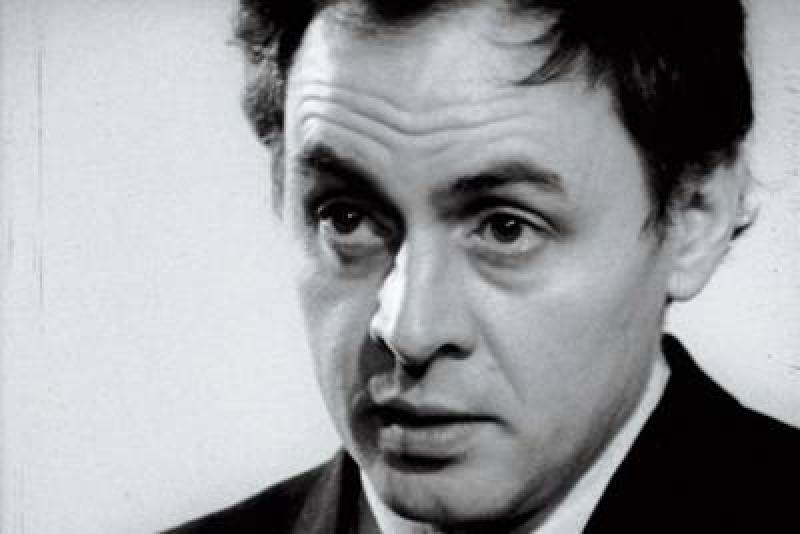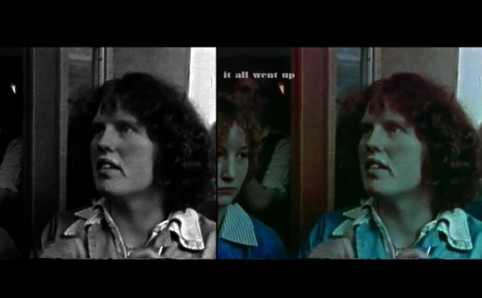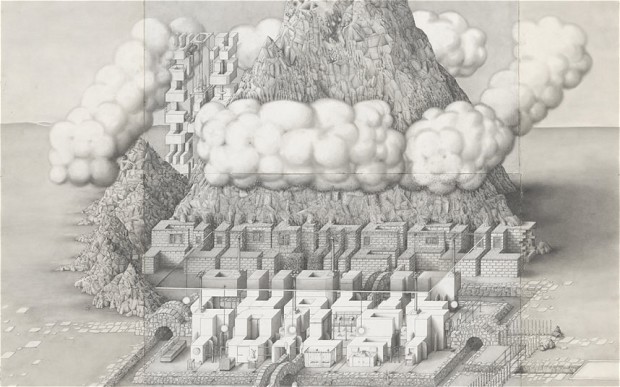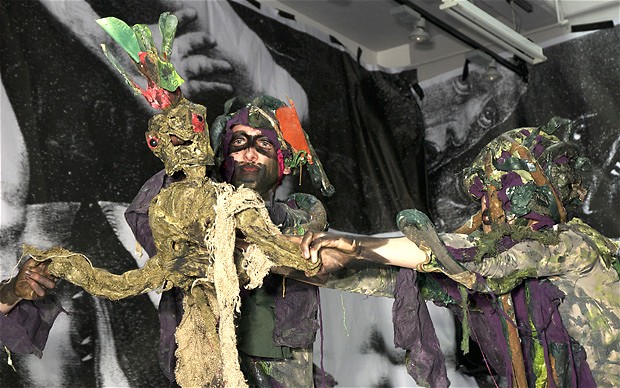Turner Prize 2012, Tate Britain | reviews, news & interviews
Turner Prize 2012, Tate Britain
Turner Prize 2012, Tate Britain
Film artists shine in this year's shortlist, but performance art gets nul points

There are two films in the Turner Prize exhibition and taken together and watched end-to-end they last just under three hours. That sounds gruelling for an art exhibition, but they’re from the strongest two candidates on this year’s shortlist. And since neither is one of those poorly filmed and edited pieces that are best viewed as moving wallpaper as you drift in and out of the gallery, both are worth devoting time to.
The first is by Elizabeth Price, which is 20-minutes long. The Woolworths Choir of 1979 (image below left) is a beautifully constructed and rather captivating, as well as disturbing film. It’s made up of three distinct but seamlessly overlapping segments. Still images, repeated motifs, archive footage, text and voiceover are all used.
 The first part is a bit like a nicely crafted PowerPoint presentation: black and white photographs featuring close-up images of gothic church architecture pop up, and a description of their functions is given through short text and voiceover. We’re briefly invited to ponder the etymologies of the words “choir” and “quire”, and each slide change is accompanied by the sound of an amplified finger-click, which could also be the sound of an old-fashioned projector changing slides. This then overlaps with pop images of girl bands – a line-up of 60s and 70s pop "choirs" overlaid with a Shangri Las soundtrack - which eventually segues into newsreel of a real event: a fire in the furniture department of a Manchester Woolworths in 1979 which killed 10 people.
The first part is a bit like a nicely crafted PowerPoint presentation: black and white photographs featuring close-up images of gothic church architecture pop up, and a description of their functions is given through short text and voiceover. We’re briefly invited to ponder the etymologies of the words “choir” and “quire”, and each slide change is accompanied by the sound of an amplified finger-click, which could also be the sound of an old-fashioned projector changing slides. This then overlaps with pop images of girl bands – a line-up of 60s and 70s pop "choirs" overlaid with a Shangri Las soundtrack - which eventually segues into newsreel of a real event: a fire in the furniture department of a Manchester Woolworths in 1979 which killed 10 people.
Aural and visual motifs connect the passages, forming rhythmic echoes. Hand gestures, for instance, are sequentially repeated, ending in an arm waving through window bars amid billowing smoke from the burning building. The film is edited very precisely, with choreographed restraint, and the effect is cumulative, seductive and powerful. It’s also chilling, and Price shows immense skill in knitting together the overlapping sequences.
Price’s film is relatively short compared to Luke Fowler’s feature-length All Selves Divides (main image), which is just over 90-minutes long. However, you’ll probably be too absorbed to notice the time. Fowler’s film, about the Scottish psychiatrist/counter-culture guru turned troubled alcoholic RD Laing, is superb. In fact, it’s an utterly fascinating and deeply empathetic portrayal of a troubled and troubling figure. The archive footage is intercut with sequences filmed by Fowler himself which are more abstract. The borrowed footage is made up of documentaries and interviews featuring Laing and his work, together with footage of documentaries featuring psychiatric encounters in traditional medical set-ups of the day. They make a compelling counterpoint.
 Fowler has made three Laing films to date. The first one was shortlisted for Beck’s Futures in 2005 and was shown at the ICA. Unlike All Selves Divided, it was badly presented by the gallery, and although certainly interesting in itself – it was about Laing’s experimental community at Kingsley Hall – the original footage seemed to have received little intervention from Fowler. All Selves Divided is far superior and is the most sophisticated of the trilogy. It would be good to see him win.
Fowler has made three Laing films to date. The first one was shortlisted for Beck’s Futures in 2005 and was shown at the ICA. Unlike All Selves Divided, it was badly presented by the gallery, and although certainly interesting in itself – it was about Laing’s experimental community at Kingsley Hall – the original footage seemed to have received little intervention from Fowler. All Selves Divided is far superior and is the most sophisticated of the trilogy. It would be good to see him win.
We then have the obsessively detailed, large-scale drawings of Paul Noble (image above right). By now most will have heard of Noble’s two-decade long project featuring the fictive Nobson Newtown. His technical draughtsmanship is superb, but ultimately, and especially in the animated spaces of the Turner Prize exhibition, the drawings appear quite lifeless. The precision may impress, but there's something just incredibly inert about the result.
 Spartacus Chetwynd is the artist who seems to have gleaned the most column inches in the broadsheet press. One can guess why – the artist apparently lives in a nudist colony in South London and presents performances which hint at Dionysian excess. However, the reality is neither very Dionysian (in one performance - image left - a dying tree oracle tells you your fate) nor very Rabelaisian (there are references to Rabelais in some scrappy cut-outs lining a wall), but is merely shambolic. What might hint at dangerous chaos, or even just exuberant fun, turns out to be one formless, flatulent mess. As art, it really couldn’t be less interesting. In any case, she appears to have confused fun with a total lack of craft – citing the Marx Brothers as an influence is the funniest thing about it.
Spartacus Chetwynd is the artist who seems to have gleaned the most column inches in the broadsheet press. One can guess why – the artist apparently lives in a nudist colony in South London and presents performances which hint at Dionysian excess. However, the reality is neither very Dionysian (in one performance - image left - a dying tree oracle tells you your fate) nor very Rabelaisian (there are references to Rabelais in some scrappy cut-outs lining a wall), but is merely shambolic. What might hint at dangerous chaos, or even just exuberant fun, turns out to be one formless, flatulent mess. As art, it really couldn’t be less interesting. In any case, she appears to have confused fun with a total lack of craft – citing the Marx Brothers as an influence is the funniest thing about it.
- Turner Prize 2012 at Tate Britain until 6 January, 2013
Explore topics
Share this article
The future of Arts Journalism
You can stop theartsdesk.com closing!
We urgently need financing to survive. Our fundraising drive has thus far raised £49,000 but we need to reach £100,000 or we will be forced to close. Please contribute here: https://gofund.me/c3f6033d
And if you can forward this information to anyone who might assist, we’d be grateful.

Subscribe to theartsdesk.com
Thank you for continuing to read our work on theartsdesk.com. For unlimited access to every article in its entirety, including our archive of more than 15,000 pieces, we're asking for £5 per month or £40 per year. We feel it's a very good deal, and hope you do too.
To take a subscription now simply click here.
And if you're looking for that extra gift for a friend or family member, why not treat them to a theartsdesk.com gift subscription?
more Visual arts
 'We are bowled over!' Thank you for your messages of love and support
Much-appreciated words of commendation from readers and the cultural community
'We are bowled over!' Thank you for your messages of love and support
Much-appreciated words of commendation from readers and the cultural community
 Lee Miller, Tate Britain review - an extraordinary career that remains an enigma
Fashion photographer, artist or war reporter; will the real Lee Miller please step forward?
Lee Miller, Tate Britain review - an extraordinary career that remains an enigma
Fashion photographer, artist or war reporter; will the real Lee Miller please step forward?
 Kerry James Marshall: The Histories, Royal Academy review - a triumphant celebration of blackness
Room after room of glorious paintings
Kerry James Marshall: The Histories, Royal Academy review - a triumphant celebration of blackness
Room after room of glorious paintings
 Folkestone Triennial 2025 - landscape, seascape, art lovers' escape
Locally rooted festival brings home many but not all global concerns
Folkestone Triennial 2025 - landscape, seascape, art lovers' escape
Locally rooted festival brings home many but not all global concerns
 Sir Brian Clarke (1953-2025) - a personal tribute
Remembering an artist with a gift for the transcendent
Sir Brian Clarke (1953-2025) - a personal tribute
Remembering an artist with a gift for the transcendent
 Emily Kam Kngwarray, Tate Modern review - glimpses of another world
Pictures that are an affirmation of belonging
Emily Kam Kngwarray, Tate Modern review - glimpses of another world
Pictures that are an affirmation of belonging
 Kiefer / Van Gogh, Royal Academy review - a pairing of opposites
Small scale intensity meets large scale melodrama
Kiefer / Van Gogh, Royal Academy review - a pairing of opposites
Small scale intensity meets large scale melodrama
 Jenny Saville: The Anatomy of Painting, National Portrait Gallery review - a protégé losing her way
A brilliant painter in search of a worthwhile subject
Jenny Saville: The Anatomy of Painting, National Portrait Gallery review - a protégé losing her way
A brilliant painter in search of a worthwhile subject
 Abstract Erotic, Courtauld Gallery review - sculpture that is sensuous, funny and subversive
Testing the boundaries of good taste, and winning
Abstract Erotic, Courtauld Gallery review - sculpture that is sensuous, funny and subversive
Testing the boundaries of good taste, and winning
 Edward Burra, Tate Britain review - watercolour made mainstream
Social satire with a nasty bite
Edward Burra, Tate Britain review - watercolour made mainstream
Social satire with a nasty bite
 Ithell Colquhoun, Tate Britain review - revelations of a weird and wonderful world
Emanations from the unconscious
Ithell Colquhoun, Tate Britain review - revelations of a weird and wonderful world
Emanations from the unconscious
 Rachel Jones: Gated Canyons, Dulwich Picture Gallery review - teeth with a real bite
Mouths have never looked so good
Rachel Jones: Gated Canyons, Dulwich Picture Gallery review - teeth with a real bite
Mouths have never looked so good

Add comment